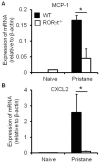RORγt modulates macrophage recruitment during a hydrocarbon oil-induced inflammation
- PMID: 24260235
- PMCID: PMC3829825
- DOI: 10.1371/journal.pone.0079497
RORγt modulates macrophage recruitment during a hydrocarbon oil-induced inflammation
Abstract
Hydrocarbon oils are often utilized as adjuvants in vaccines. In response to naturally occurring hydrocarbon oils, inflammation is initiated and persists with the continuous recruitment of immune cells such as macrophages and neutrophils. However, the mechanism underlying the chronic inflammation in response to hydrocarbon oils is not fully defined. In this study, we revealed an essential role of retinoid-related orphan receptor gamma t (RORγt) in sustaining the recruitment of macrophages following pristane treatment. RORγt absence resulted in the incompetent formation of mesenteric oil granulomas which may associate to a reduction in the migration of macrophages into the mesentery during pristane-induced inflammation. This is at least partially dependent on the expression of the monocyte chemoattractant protein-1 (MCP-1) in the mesentery and the decrease in the macrophage reservoir in the spleen. However, the absence of RORγt had no impact on the recruitment of neutrophils to the mesentery after pristane treatment. Our data uncovered an important role of RORγt in the recruitment of macrophages during hydrocarbon oil-induced chronic inflammation.
Conflict of interest statement
Figures




References
-
- Spickard A 3rd, Hirschmann JV (1994) Exogenous lipoid pneumonia. Arch Intern Med 154: 686–692. - PubMed
-
- Anderson PN, Potter M (1969) Induction of plasma cell tumours in BALB-c mice with 2,6,10,14-tetramethylpentadecane (pristane). Nature 222: 994–995. - PubMed
-
- Potter M, Maccardle RC (1964) Histology of Developing Plasma Cell Neoplasia Induced by Mineral Oil in Balb/C Mice. J Natl Cancer Inst 33: 497–515. - PubMed
Publication types
MeSH terms
Substances
LinkOut - more resources
Full Text Sources
Other Literature Sources
Research Materials
Miscellaneous

